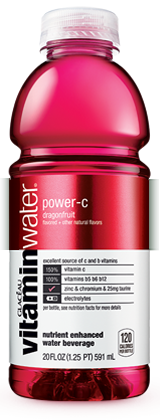Enhanced Water’s Second Wave

To me, the beauty of the enhanced water segment, from a marketing perspective, is that it doesn’t ask consumers to radically change their consumption habits, but rather coaxes them into drinking a sugared water (albeit a little less sugar than those in CSDs) by offering the psychological cover of a modest level of nutrient reinforcement. Never mind just how much vitamin content the drink contains, or whether these are nutrients that the body isn’t getting through its regular diet, or how well they’re processed by the body. My hunch is, most consumers don’t really care. Perhaps subconsciously, they want the cloak of nutrition to cover for their sweet tooth.
Vitaminwater led the charge into a new segment that had been flicked at by predecessors like SoBe, and garnered that staggering $4.1 billion buyout. The history gets interesting at this point. Immediately in the wake of the Glaceau deal, no small number of entrepreneurs made the assumption that, with the most valuable brand suddenly snatched from the independent DSD distribution system, there was a void. We saw an onrush of entrants trying to fill that gap, either with formulations that offered more meaningful vitamin reinforcement than the pixie-dust quantities in Vitaminwater or with some other enhancing ingredients, from antioxidants to functional compounds. Established beverage companies also felt they needed to respond: Pepsi stepped up its marketing behind its neglected SoBe brand, while Dr Pepper Snapple introduced Snapple Antioxidant Water. At one point, Talking Rain’s ActivWater came close to forging a strategic alliance with brewer Anheuser-Busch – even booking a space in New York in which to make the announcement, before the plan fell through at the last minute. All those brands except SoBe pretty much sputtered out, and even SoBe has seemed to survive mainly as a tactical value brand. Witnessing all these shortfalls, it was easy to convince oneself that enhanced water might be one of those segments, like kombucha and energy shots, that’s well-enough-served by a single premium entry.
Meanwhile, in the hands of Coke, Vitaminwater has, surprisingly quickly, descended into promotional hell, going well beyond even already-aggressive 10-for-$10 deals. It’s never been clear to me why a company that paid such a premium price for Glaceau would waste so little time in ending the premium positioning of its core brand, but never mind that. The price moves took all the air out of the market, making it untenable for new players, much like the relentless promotion of Gatorade and Powerade makes it nearly impossible for new sports drinks to get a footing.
End of story, then? That’s what many of us assumed. But bless the beverage business, it never ceases to regenerate itself. So in the past few years, we’ve seen a startling new burst of innovation, and some shows signs of sticking. It’s a remarkable turn of events, given the prior history of the segment.

More surprising have been the other entrants – most of all, Sparkling Ice, from a new regime at Talking Rain, the company that earlier failed with ActivWater. Their strategies are a bit more amorphous than the cap-dispensed breed. Sparkling Ice is simple in concept and employs the artificial preservatives and coloring agents that, if you believe marketing surveys, consumers say they’re increasingly inclined to reject.

Also vying for similar consumers are easier-drinking functional items that blur the line with enhanced water, such as Bai-5 and Neuro, and flavored waters like La Croix and Cascade Ice. A few brands are melding nutrition and energy, such as Rockstar Energy Water and a startup from Vitaminwater vets called Agua Enerviva. It’s all brought us a summer selling season that is brought first real drama in years to an enhanced water segment that was lacking not just vitamins, but of pizzazz and excitement.


Receive your free magazine!
Join thousands of other food and beverage professionals who utilize BevNET Magazine to stay up-to-date on current trends and news within the food and beverage world.
Receive your free copy of the magazine 6x per year in digital or print and utilize insights on consumer behavior, brand growth, category volume, and trend forecasting.
Subscribe